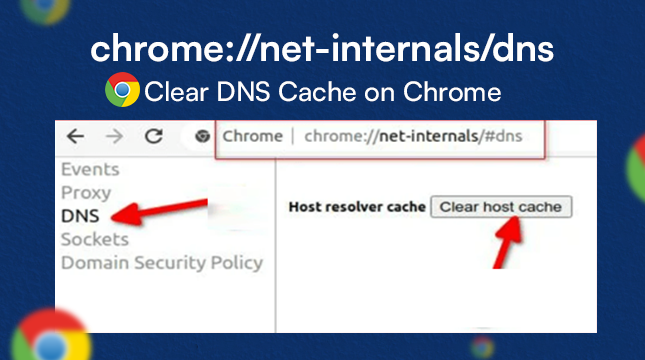Introduction: Chrome.//Net-Internals/Dns
In the realm of internet browsing and network troubleshooting, understanding how DNS (Domain Name System) works is crucial. DNS is the system that translates human-readable domain names (like example.com) into IP addresses (such as 192.0.2.1) that computers use to locate resources on the internet. Chrome’s chrome://net-internals/#dns page, also known as Chrome Net Internals DNS, offers users and developers a powerful toolset for monitoring and diagnosing DNS-related activities within the Chrome browser environment.
Understanding DNS and Its Importance
DNS is often referred to as the “phonebook of the internet,” enabling users to access websites, send emails, and perform various online activities using familiar domain names instead of complex IP addresses. When you enter a domain name into Chrome’s address bar, the browser initiates DNS queries to translate that domain name into an IP address, allowing it to connect to the desired web server.
Features and Functionality of Chrome Net Internals DNS
- DNS Query Logging:
- The
chrome://net-internals/#dnspage logs detailed information about each DNS query initiated by Chrome. This includes the domain name queried, the type of query (A, AAAA, CNAME, etc.), the IP addresses returned by DNS servers, and timestamps indicating when the query occurred. - Users can view this logging information to troubleshoot DNS-related issues, track DNS resolution times, and analyze DNS query patterns affecting browsing performance.
- The
- DNS Cache Inspection:
- Chrome maintains a DNS cache to store recently resolved domain names and their corresponding IP addresses. The
chrome://net-internals/#dnspage allows users to inspect the contents of this cache, providing visibility into which domain names are currently cached and their expiration times. - Clearing the DNS cache from this interface can help resolve DNS-related problems caused by outdated or incorrect cache entries, ensuring accurate and up-to-date DNS resolution.
- Chrome maintains a DNS cache to store recently resolved domain names and their corresponding IP addresses. The
- Query Analysis and Timing Data:
- For each DNS query recorded in the logs, Chrome Net Internals DNS provides comprehensive timing data. This includes the duration of each query, latency metrics indicating network responsiveness, and status indicators (success, failure) to identify issues with DNS server responsiveness or connectivity.
- Developers and network administrators can leverage this data to optimize DNS configurations, diagnose connectivity issues, and improve the overall performance of web applications relying on DNS resolution.
- Experimental Features and Advanced Settings:
- The
chrome://net-internals/#dnspage may include access to experimental features or advanced settings related to DNS resolution. These features allow users to test emerging technologies like DNS-over-HTTPS (DoH), customize DNS server preferences, or integrate with external DNS services for enhanced security and privacy. - Advanced users and developers interested in DNS management can explore these settings to implement cutting-edge DNS protocols or configure Chrome’s DNS behavior according to specific use cases or network environments.
- The
Practical Applications and Benefits
- Troubleshooting DNS Issues: Use Chrome Net Internals DNS to diagnose common DNS problems such as DNS server misconfigurations, DNS lookup failures, or issues with domain name resolution affecting web browsing performance.
- Monitoring Network Performance: Analyze DNS query logs and cache behavior to identify performance bottlenecks, optimize DNS settings, and ensure efficient use of network resources for Chrome users.
- Security Considerations: Stay vigilant against DNS-related attacks such as DNS spoofing or cache poisoning by monitoring for suspicious DNS query patterns or unexpected IP resolutions logged on the
chrome://net-internals/#dnspage. - Educational Resource: Chrome Net Internals DNS serves as an educational tool for users seeking to understand the fundamentals of DNS resolution, caching mechanisms, and the impact of DNS on internet connectivity and web application performance.
Using Chrome Net Internals DNS Effectively
- Accessing the Tool: To access Chrome Net Internals DNS, open your Chrome browser and enter
chrome://net-internals/#dnsinto the address bar. This will direct you to the DNS diagnostics interface where you can explore logs, inspect cache entries, and adjust settings related to DNS resolution. - Best Practices: Regularly review DNS query logs, monitor cache usage, and leverage advanced features to optimize DNS performance and troubleshoot connectivity issues proactively.
- Community and Support: Engage with the Chrome community or seek support from Chrome’s official resources to exchange insights, share best practices, and stay informed about updates and advancements in DNS management within Chrome.
Conclusion
Chrome Net Internals DNS is a valuable tool for users, developers, and network administrators alike, offering insights into DNS resolution processes, cache management, and network performance optimization within the Chrome browser ecosystem. By harnessing the capabilities of chrome://net-internals/#dns, users can enhance browsing experiences, troubleshoot DNS-related issues effectively, and deepen their understanding of DNS’s role in internet connectivity.
